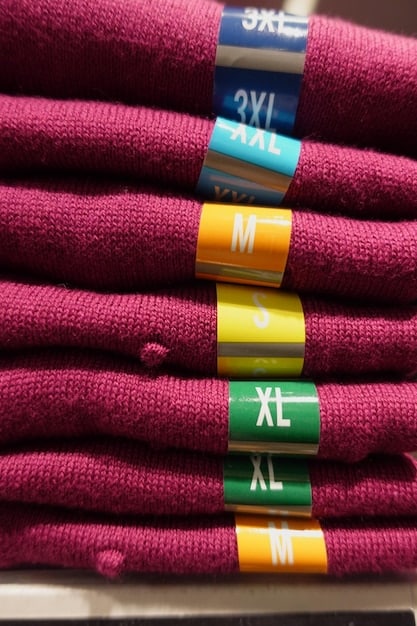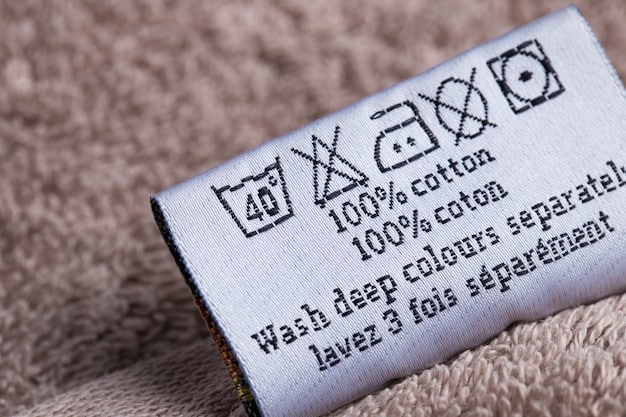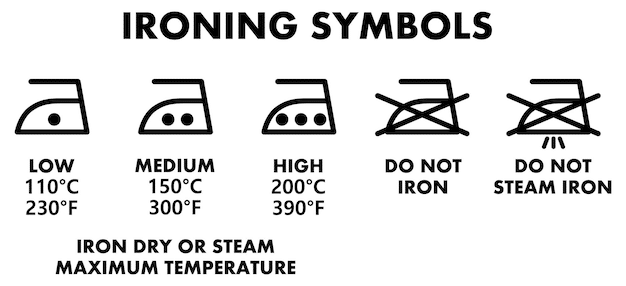Decoding Clothing Labels: A US Consumer’s Guide

Advertisements
Decoding clothing labels helps US consumers understand fabric composition and care instructions, ensuring proper garment maintenance and longevity, while aiding informed purchasing decisions.
Ever felt lost staring at the cryptic symbols and text on your clothing labels? You’re not alone. Decoding clothing labels: understanding fabric composition and care instructions for US consumers can be easily done with this guide.
Advertisements
The Importance of Reading Clothing Labels
Clothing labels are more than just tags; they’re a wealth of information crucial for maintaining the quality and lifespan of your garments. Understanding what they mean empowers you to make informed decisions about how to care for your clothes.
Why Bother Decoding?
Ignoring clothing labels can lead to costly mistakes, like shrinking your favorite sweater or fading vibrant colors.
Advertisements
Decoding clothing labels saves you money, time, and frustration by guiding you on proper washing and drying methods.
What Information Can You Find on a Clothing Label?
- Fabric Composition: Discover the materials your garment is made of, such as cotton, polyester, or a blend.
- Care Instructions: Learn the recommended washing, drying, ironing, and dry-cleaning methods.
- Country of Origin: See where the garment was manufactured.
- Manufacturer Information: Find the brand name and contact details.
Decoding clothing labels unlocks a treasure trove of details designed to help you get the most out of your wardrobe.
Understanding Fabric Composition
Fabric composition is a fundamental element on clothing labels, revealing the materials used to create your garment. This knowledge is key to proper care and maintaining the fabric’s integrity.
Common Fabric Types
Familiarizing yourself with common fabric types is the first step in decoding clothing labels. Here are some frequently encountered materials:
- Cotton: Known for its breathability and comfort, cotton is a staple in many wardrobes.
- Polyester: A durable and wrinkle-resistant synthetic fabric often blended with other materials.
- Linen: A lightweight and breathable natural fiber perfect for warm weather.
- Silk: A luxurious and delicate fabric requiring special care.
Understanding these basic fabric types allows you to anticipate how a garment will feel, drape, and require maintenance.
Fabric Blends
Many garments feature fabric blends, combining the properties of two or more materials. These blends are designed to enhance specific characteristics of the fabric.

For example, a cotton-polyester blend can offer the comfort of cotton with the added durability and wrinkle resistance of polyester.
Decoding Wash Symbols: The Key to Clean Clothes
Wash symbols on clothing labels provide vital guidance on how to wash your garments effectively without causing damage. Master these symbols, and you’re well on your way to laundry success.
Basic Wash Symbols
The wash tub symbol is the most common, representing the washing process. Variations indicate the water temperature and washing machine settings.
A wash tub with a number indicates the maximum water temperature in degrees Celsius or Fahrenheit. A wash tub with lines underneath signifies the need for a gentle or permanent press cycle.
Decoding Water Temperature
Water temperature plays a crucial role in preventing shrinkage and color bleeding.
Cold water is generally recommended for delicate items and to prevent colors from fading. Warm water is suitable for most everyday laundry, while hot water is best for heavily soiled items.
Decoding clothing labels in terms of water temperature ensures your clothes remain vibrant and properly sized.
Understanding Drying Symbols for Optimal Garment Care
Drying symbols are as important as wash symbols, guiding you on the proper drying methods to prevent shrinkage, warping, and other damage. Knowing these symbols will significantly extend the life of your clothes.
Common Drying Symbols
The square is the primary symbol for drying. A circle inside the square indicates tumble drying, while variations within the circle denote specific heat settings.
A square with a line in the middle represents line drying, and a square with lines in the corner signifies drying flat.
Interpreting Heat Settings
Heat settings impact the texture and shape of your clothes during the drying process. High heat is suitable for durable items like towels and jeans, while low heat is best for delicate fabrics.
- High Heat: Ideal for sturdy fabrics that can withstand intense heat.
- Medium Heat: Suitable for most everyday items like cotton shirts and pants.
- Low Heat: Recommended for delicate fabrics like silk, lace, and synthetic blends.
- No Heat/Air Dry: Best for items prone to shrinking or damage from heat.
Paying attention to heat settings when decoding clothing labels will keep your clothes looking their best.
Ironing Symbols: Achieving Wrinkle-Free Perfection
Ironing symbols on clothing labels guide you on the appropriate ironing techniques and heat settings to achieve wrinkle-free results without damaging your garments. Decoding these symbols ensures your clothes always look crisp and polished.
The Iron Symbol
The iron symbol represents the ironing process. Dots inside the iron indicate the recommended heat setting, with one dot representing low heat, two dots for medium heat, and three dots for high heat.
Decoding Heat Settings for Ironing
Choosing the right heat setting is essential for preventing scorching or melting delicate fabrics.

- One Dot (Low Heat): Ideal for delicate fabrics like silk and synthetic blends.
- Two Dots (Medium Heat): Suitable for cotton, linen, and other moderately heat-resistant fabrics.
- Three Dots (High Heat): Best for durable fabrics like denim and heavy cotton.
Decoding clothing labels for ironing helps you achieve smooth, wrinkle-free results every time.
Dry Cleaning Symbols: When to Call the Professionals
Dry cleaning symbols indicate when a garment requires professional cleaning methods. These symbols often appear on delicate or structured items that may not withstand regular washing.
Recognizing Dry Cleaning Symbols
The circle is the primary symbol for dry cleaning. A plain circle indicates that the garment can be dry cleaned, while variations inside the circle specify the types of solvents that can be used.
A circle with a line through it means the garment should not be dry cleaned.
Specific Dry Cleaning Instructions
Some labels may include additional instructions for dry cleaners, such as specifying particular solvents or cleaning processes that are safe for the fabric.
Proper identification of dry cleaning needs when decoding clothing labels will protect your investment in specialty garments.
| Key Point | Brief Description |
|---|---|
| 🧵 Fabric Composition | Identifies the materials used (e.g., cotton, polyester) for care. |
| 💧 Wash Symbols | Indicates water temperature and washing machine settings. |
| Dryer Symbols | Guides on proper drying methods to prevent damage. |
| Ironing Symbols | Specifies heat settings for wrinkle-free results. |
Frequently Asked Questions
▼
Reading clothing labels ensures you care for your garments correctly, preventing damage like shrinkage or color fading. It also provides information about the fabric composition. Understanding the label prolongs the life of your favorite clothes.
▼
The wash tub symbol represents the washing process. Variations include temperature settings and cycle types like gentle or permanent press. These details ensure you wash the garment at the correct setting and without causing damage.
▼
Drying symbols, typically squares with circles inside, indicate whether a garment can be tumble dried. Lines within the square specify line drying or drying flat. Heat settings are crucial and are also indicated by the symbols.
▼
Dots on the iron symbol represent the heat setting, with one dot for low heat, two for medium, and three for high heat. Always start with a lower setting to prevent scorching; increase as needed based on the fabric.
▼
If the clothing label features a circle as the primary symbol, then it should only be dry cleaned. Dry cleaning is best for delicate fabrics, structured items, and clothes that could potentially be damaged through home washing settings.
Conclusion
Decoding clothing labels: understanding fabric composition and care instructions for US consumers empowers you to extend the life of your favorite clothes, save money, and minimize laundry mishaps. By mastering these symbols and guidelines, you can confidently care for your wardrobe and keep it looking its best.